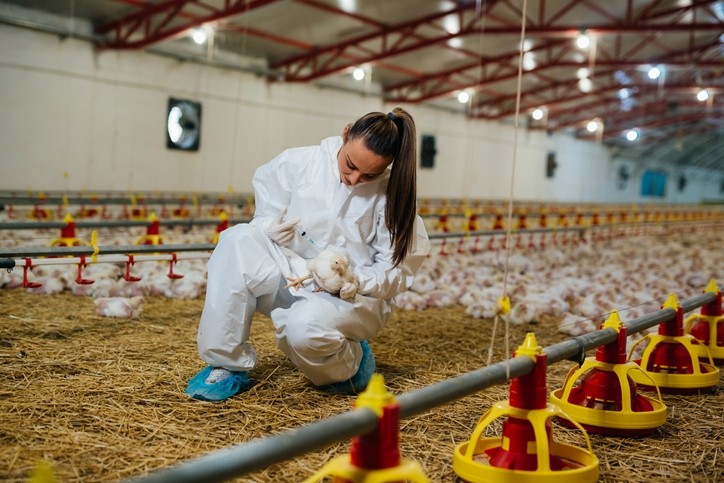Study: Larvae has potential to benefit broiler welfare and increase productivity

Adding black soldier fly larvae (BSFL) to broiler diets can improve leg health, litter quality, and can aid production performance, according to a paper published in Physiology & Behavior.
However, the effects likely depend on the way BSFL are provided, said the researchers, all based at Wageningen University & Research (WUR), in the Netherlands.
For example, dietary full-fat or defatted BSFL meal has been reported to increase broiler body weight gain and feed intake, enhance innate immune activity, and stimulate a more diverse caecal microbiota composition, they said.
Some studies indicate dietary BSFL oil does not affect broiler body weight gain and feed intake, and it has minimal effects on gastro-intestinal tract development, while additional papers have demonstrated that the provision of live BSFL in feeding trays does not affect body weight gain, but can cause a more diverse caecal microbiota composition, noted the WUR team.
Variability in the observed effects of different BSFL forms will partly be due to different inclusion levels across studies though, added the authors.
Before August 2021 only whole live insects and insect fat could be included in pig and poultry feed in the EU, but Commission Regulation 2021/1372 changed this to also allow processed insect protein to be included in monogastric diets.
The goal
The team said the aim of their study was to determine the effects of different BSFL forms - BSFL meal and oil incorporated in the feed, dried BSFL, and live BSFL - and different delivery methods - in the feeder or scattered across the pen - on various indicators of broiler welfare including behavior, health, corticosterone and serotonin concentrations and production performance: body weight gain and feed intake.
“We hypothesized that incorporating BSFL meal and oil in the diet and providing dried BSFL in the feeder would be less effective in stimulating broiler activity and therefore less beneficial for welfare than scattering dried or live BSFL through the pen. In addition, we expected that scattering live BSFL would be more attractive to broilers and thereby more proficient in improving broiler welfare than scattering dried BSFL. Furthermore, based on the expected effect on activity, it is possible that the different BSFL supplementations strategies will have differential effects on broiler production performance.”
The study
The study included 1,680 male broilers. The trial was carried out at the research facility of ForFarmers in Bathmen in the Netherlands.
Broilers in the control (CON) treatment did not receive any black soldier fly larvae (BSFL). In the four BSFL treatments, 8% of the ingredients from the CON pellets was replaced by BSFL on a dry matter (DM) basis as follows: BSFL meal and oil incorporated in the pellets and thus provided in the feeder (INC-F), dried whole BSFL provided in the feeder (D-F), dried whole BSFL scattered through the pen (D-S), or live BSFL scattered through the pen (L-S).
Dried and live larvae were provided in four equal daily portions at three-hour intervals.
All broilers were fed a three-phase diet, with starter feed provided on day 1–9, grower feed provided on day 9–27, and finisher feed provided on day 27–35.
Findings
Compared to a diet without BSFL, the authors saw that scattering dried or live larvae through the pen increased active behaviors, though only live larvae increased the time broilers spent standing.
Broilers in the D-F, D-S and L-S treatments had higher average daily body weight gain during some periods, and they had higher final weights, despite L-S broilers having a lower total dry matter intake than CON broilers.
The researchers also saw that the dry matter conversion ratio of INC-F, D-S and L-S broilers was reduced, while, at the end of the rearing period, pens in all dietary BSFL treatments had better litter quality than CON pens. Furthermore, food pad dermatitis was less severe for INC-F and D-S broilers than for CON broilers, and for L-S broilers than for broilers in all other treatments, while hock burn severity was less for L-S than for CON broilers, they added.
Broiler lameness, cleanliness, plasma natural antibody titers, and whole blood serotonin were not influenced by any dietary BSFL approaches though.
“Replacing 8% of the diet of broilers with BSFL meal and oil incorporated in feed pellets, dried larvae provided in the feeder or scattered through the pen four times a day, or live larvae scattered through the pen four times a day all increased broiler average daily gains and/or dry matter conversion ratio, and improved litter quality.
“Incorporating BSFL meal and oil in the diet and scattering dried or live larvae through the pen improved broiler leg health, and scattering larvae also increased broiler activity," noted the team.
Plasma natural antibodies and whole blood serotonin concentrations were not influenced by dietary BSFL. Feather corticosterone concentrations were affected by BSFL provisioning, though post-hoc differences between treatments were absent, they said.
“Overall, we confirmed that processed and live BSFL can benefit broiler welfare and increase broiler production performance. Scattering BSFL through the pen results in more welfare benefits than providing BSFL in the feeder, with live BSFL having the strongest effects on broiler behavior and leg health, and therefore being most beneficial for broiler welfare,” concluded the authors.












